Abstract
Bacterial counts were carried out on the faeces of 160 patients receiving clindamycin or lincomycin treatment for bacterial infections. In all the patients the total bacteroides count was significantly reduced while strains of Enterobacteriaciae, yeasts, and streptococci were correspondingly increased. Severe diarrhoea developed in 25 (16%) patients, but this could not be related to a change in faecal flora. Diarrhoea was most common when clindamycin was given prophylactically, women were more affected than men, and the incidence was highest in those aged over 60 years. No cases of pseudomembranous colitis were seen. Although clindamycin is a valuable antibiotic for treating established severe anaerobic bacterial infections it should be used cautiously in elderly patients.
Full text
PDF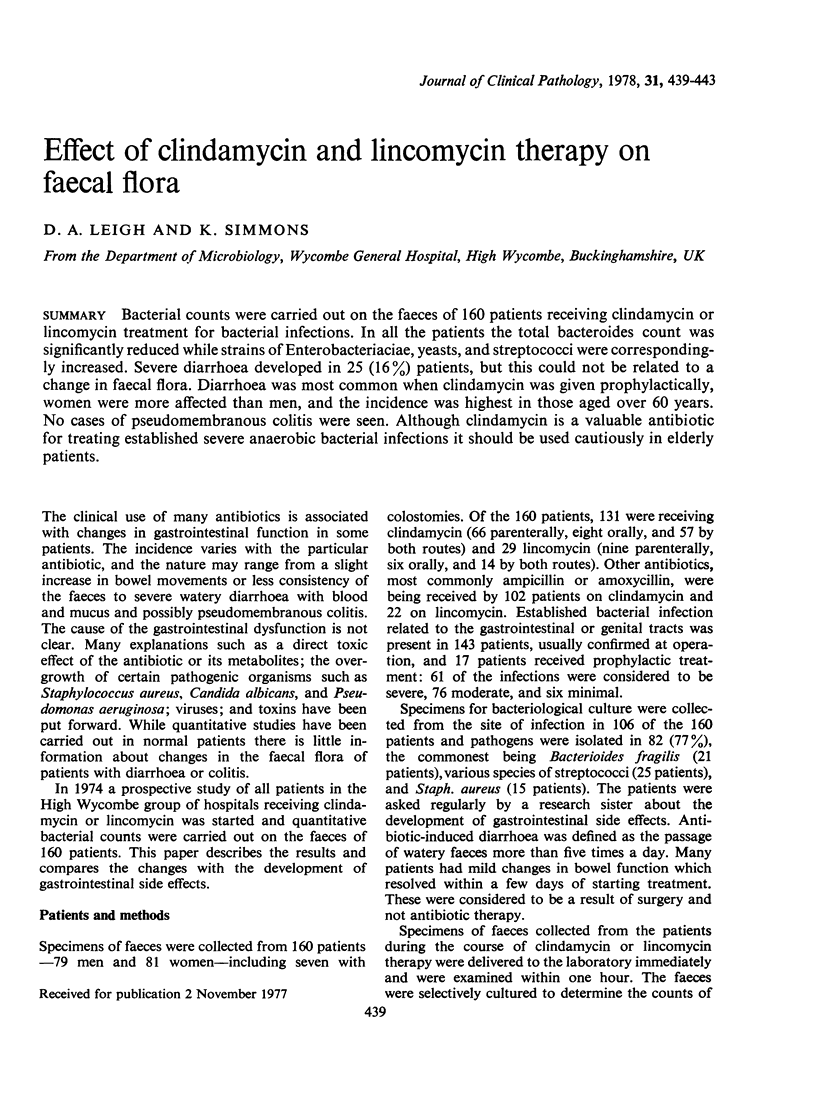
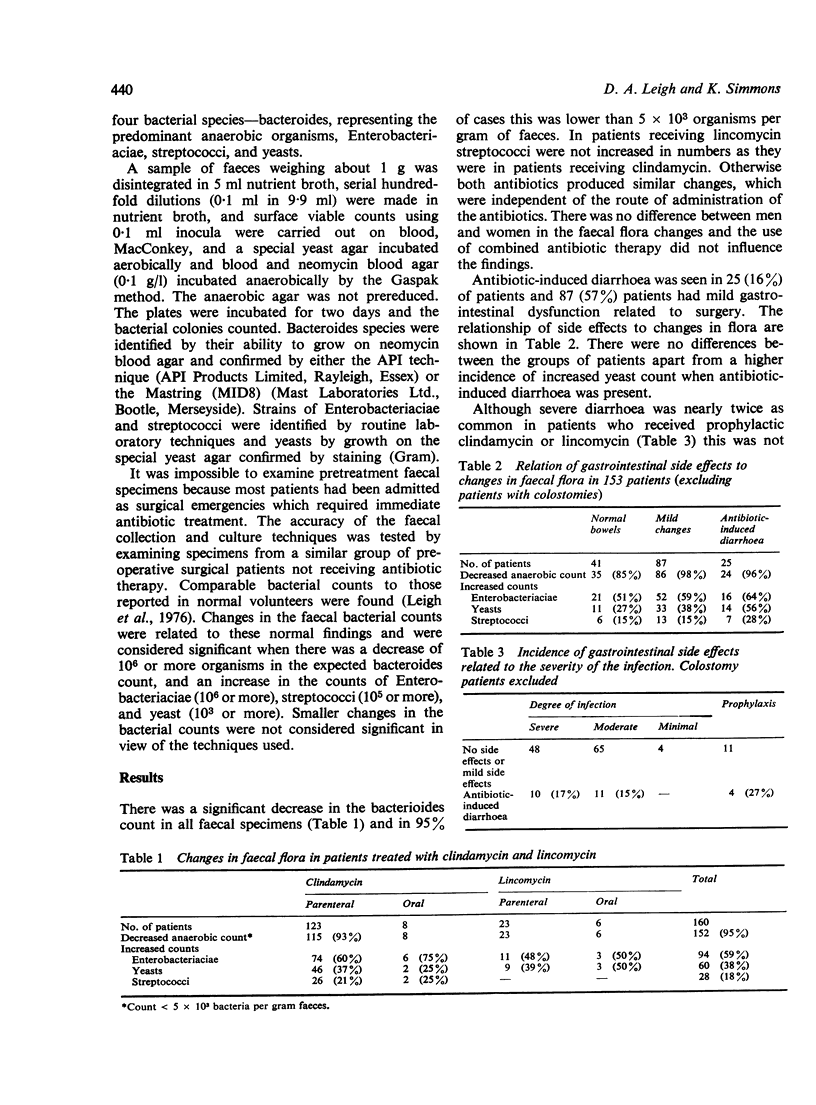
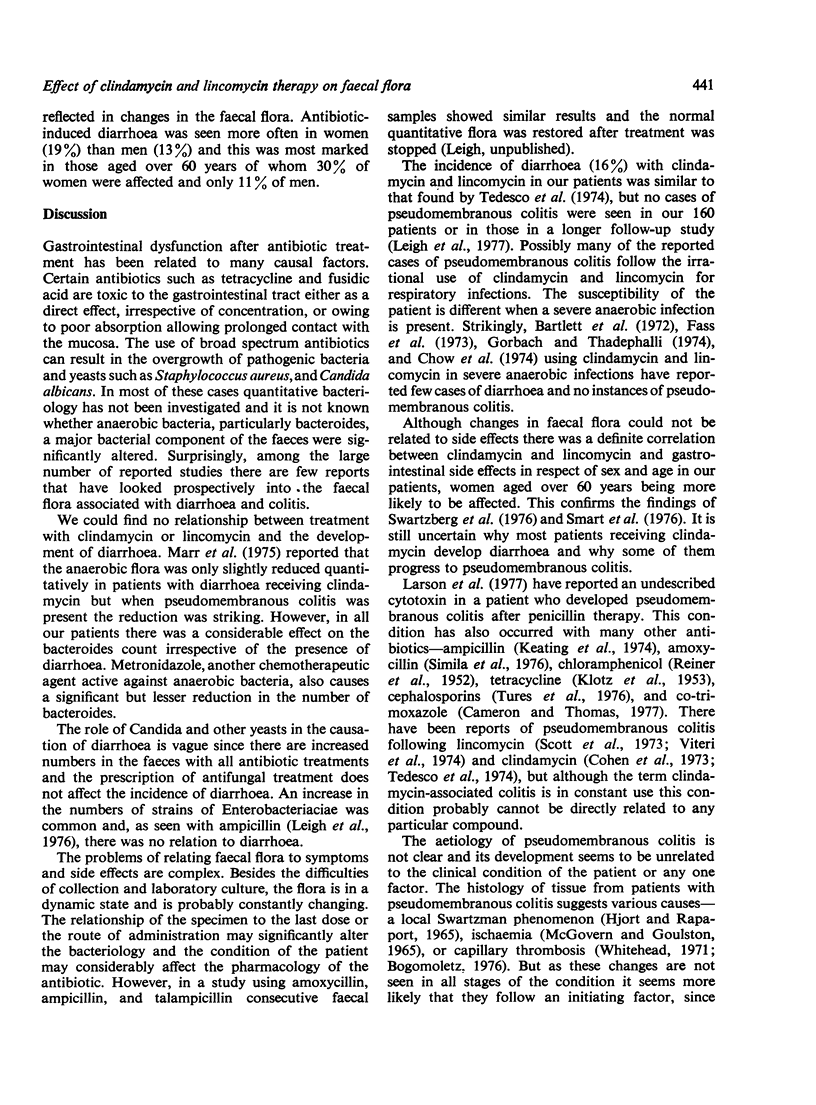
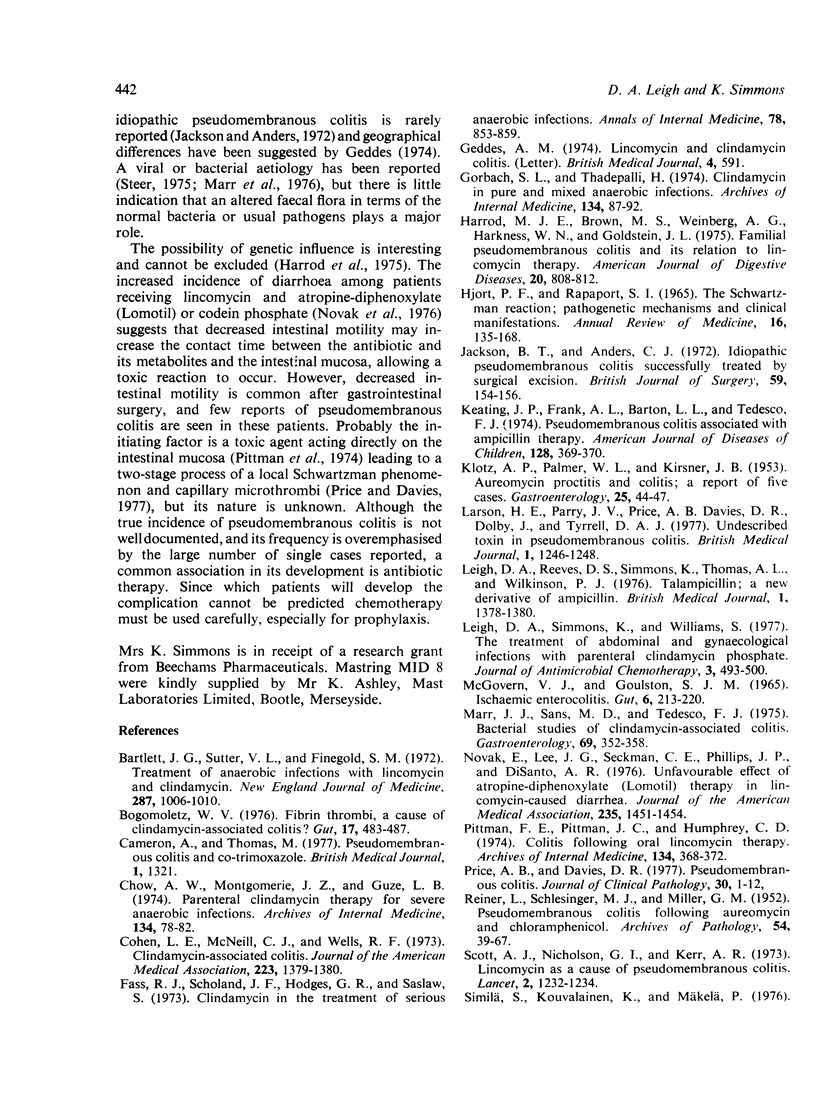
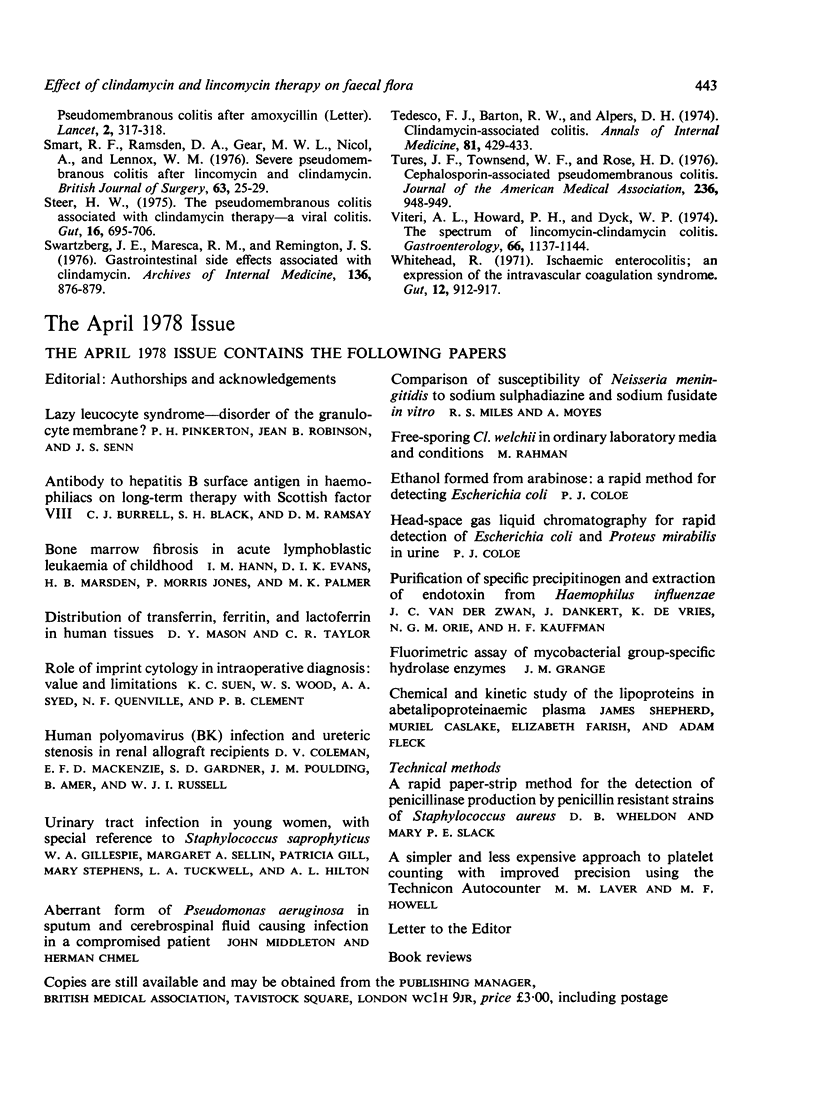
Selected References
These references are in PubMed. This may not be the complete list of references from this article.
- Bartlett J. G., Sutter V. L., Finegold S. M. Treatment of anaerobic infections with lincomycin and clindamycin. N Engl J Med. 1972 Nov 16;287(20):1006–1010. doi: 10.1056/NEJM197211162872002. [DOI] [PubMed] [Google Scholar]
- Bogomoletz W. V. Fibrin thrombi, a cause of clindamycin-associated colitis? Gut. 1976 Jun;17(6):483–487. doi: 10.1136/gut.17.6.483. [DOI] [PMC free article] [PubMed] [Google Scholar]
- Cameron A., Thomas M. Pseudomembranous colitis and co-trimoxazole. Br Med J. 1977 May 21;1(6072):1321–1321. doi: 10.1136/bmj.1.6072.1321. [DOI] [PMC free article] [PubMed] [Google Scholar]
- Chow A. W., Montgomerie J. Z., Guze L. B. Parenteral clindamycin therapy for severe anaerobic infections. Arch Intern Med. 1974 Jul;134(1):78–82. [PubMed] [Google Scholar]
- Cohen L. E., McNeill C. J., Wells R. F. Clindamycin-associated colitis. JAMA. 1973 Mar 19;223(12):1379–1380. [PubMed] [Google Scholar]
- Fass R. J., Scholand J. F., Hodges G. R., Saslaw S. Clindamycin in the treatment of serious anaerobic infections. Ann Intern Med. 1973 Jun;78(6):853–859. doi: 10.7326/0003-4819-78-6-853. [DOI] [PubMed] [Google Scholar]
- Gorbach S. L., Thadepalli H. Clindamycin in pure and mixed anaerobic infections. Arch Intern Med. 1974 Jul;134(1):87–92. [PubMed] [Google Scholar]
- HJORT P. F., RAPAPORT S. I. THE SHWARTZMAN REACTION: PATHOGENETIC MECHANISMS AND CLINICAL MANIFESTATIONS. Annu Rev Med. 1965;16:135–168. doi: 10.1146/annurev.me.16.020165.001031. [DOI] [PubMed] [Google Scholar]
- Harrod M. J., Brown M. S., Weinberg A. G., Harkness W. N., Goldstein J. L. Familial pseudomembranous colitis and its relation to lincomycin therapy. Am J Dig Dis. 1975 Sep;20(9):808–812. doi: 10.1007/BF01070948. [DOI] [PubMed] [Google Scholar]
- Jackson B. T., Anders C. J. Idiopathic pseudomembranous colitis successfully treated by surgical excision. Br J Surg. 1972 Feb;59(2):154–156. doi: 10.1002/bjs.1800590222. [DOI] [PubMed] [Google Scholar]
- KLOTZ A. P., PALMER W. L., KIRSNER J. B. Aureomycin proctitis and colitis: a report of five cases. Gastroenterology. 1953 Sep;25(1):44–47. [PubMed] [Google Scholar]
- Keating J. P., Frank A. L., Barton L. L., Tedesco F. J. Pseudomembranous colitis associated with ampicillin therapy. Am J Dis Child. 1974 Sep;128(3):369–370. doi: 10.1001/archpedi.1974.02110280099014. [DOI] [PubMed] [Google Scholar]
- Larson H. E., Parry J. V., Price A. B., Davies D. R., Dolby J., Tyrrell D. A. Undescribed toxin in pseudomembranous colitis. Br Med J. 1977 May 14;1(6071):1246–1248. doi: 10.1136/bmj.1.6071.1246. [DOI] [PMC free article] [PubMed] [Google Scholar]
- Leigh D. A., Reeves D. S., Simmons K., Thomas A. L., Wilkinson P. J. Talampicillin: a new derivative of ampicillin. Br Med J. 1976 Jun 5;1(6022):1378–1380. doi: 10.1136/bmj.1.6022.1378. [DOI] [PMC free article] [PubMed] [Google Scholar]
- Leigh D. A., Simmons K., Williams S. The treatment of abdominal and gynaecological infections with parenteral clindamycin phosphate. J Antimicrob Chemother. 1977 Sep;3(5):493–500. doi: 10.1093/jac/3.5.493. [DOI] [PubMed] [Google Scholar]
- Letter: Lincomycin and clindamycin colitis. Br Med J. 1974 Dec 7;4(5944):591–591. doi: 10.1136/bmj.4.5944.591-a. [DOI] [PMC free article] [PubMed] [Google Scholar]
- Marr J. J., Sans M. D., Tedesco F. J. Bacterial studies of Clindamycin-associated colitis. A preliminary report. Gastroenterology. 1975 Aug;69(2):352–358. [PubMed] [Google Scholar]
- McGovern V. J., Goulston S. J. Ischaemic enterocolitis. Gut. 1965 Jun;6(3):213–220. doi: 10.1136/gut.6.3.213. [DOI] [PMC free article] [PubMed] [Google Scholar]
- Novak E., Lee J. G., Seckman C. E., Phillips J. P., DiSanto A. R. Unfavorable effect of atropine-diphenoxylate (Lomotil) therapy in lincomycin-caused diarrhea. JAMA. 1976 Apr 5;235(14):1451–1454. [PubMed] [Google Scholar]
- Pittman F. E., Pittman J. C., Humphrey C. D. Colitis following oral lincomycin therapy. Arch Intern Med. 1974 Aug;134(2):368–372. [PubMed] [Google Scholar]
- Price A. B., Davies D. R. Pseudomembranous colitis. J Clin Pathol. 1977 Jan;30(1):1–12. doi: 10.1136/jcp.30.1.1. [DOI] [PMC free article] [PubMed] [Google Scholar]
- REINER L., SCHLESINGER M. J., MILLER G. M. Pseudomembranous colitis following aureomycin and chloramphenicol. AMA Arch Pathol. 1952 Jul;54(1):39–67. [PubMed] [Google Scholar]
- Scott A. J., Nicholson G. I., Kerr A. R. Lincomycin as a cause of pseudomembranous colitis. Lancet. 1973 Dec 1;2(7840):1232–1234. doi: 10.1016/s0140-6736(73)90973-2. [DOI] [PubMed] [Google Scholar]
- Simila S., Kouvalainen K., Makela P. Letter: Pseudomembranous colitis after amoxycillin. Lancet. 1976 Aug 7;2(7980):317–318. doi: 10.1016/s0140-6736(76)90773-x. [DOI] [PubMed] [Google Scholar]
- Smart R. F., Ramsden D. A., Gear M. W., Nicol A., Lennox W. M. Severe pseudomembranous colitis after lincomycin and clindamycin. Br J Surg. 1976 Jan;63(1):25–29. doi: 10.1002/bjs.1800630106. [DOI] [PubMed] [Google Scholar]
- Steer H. W. The pseudomembranous colitis associated with clindamycin therapy--a viral colitis. Gut. 1975 Sep;16(9):695–706. doi: 10.1136/gut.16.9.695. [DOI] [PMC free article] [PubMed] [Google Scholar]
- Swartzberg J. E., Maresca R. M., Remington J. S. Gastrointestinal side effects associated with clinidamycin. 1,000 consecutive patients. Arch Intern Med. 1976 Aug;136(8):876–879. [PubMed] [Google Scholar]
- Tedesco F. J., Barton R. W., Alpers D. H. Clindamycin-associated colitis. A prospective study. Ann Intern Med. 1974 Oct;81(4):429–433. doi: 10.7326/0003-4819-81-4-429. [DOI] [PubMed] [Google Scholar]
- Tures J. F., Townsend W. F., Rose H. D. Cephalosporin-associated pseudomembranous colitis. JAMA. 1976 Aug 23;236(8):948–949. [PubMed] [Google Scholar]
- Viteri A. L., Howard P. H., Dyck W. P. The spectrum of lincomycin-clindamycin colitis. Gastroenterology. 1974 Jun;66(6):1137–1144. [PubMed] [Google Scholar]
- Whitehead R. Ischaemic enterocolitis: an expression of the intravascular coagulation syndrome. Gut. 1971 Nov;12(11):912–917. doi: 10.1136/gut.12.11.912. [DOI] [PMC free article] [PubMed] [Google Scholar]


